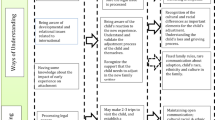Abstract
When a child from China is adopted by U.S. parents, the adoptive family must address questions about if, when, how, and how much to acknowledge the birth cultural heritage of their child. This paper addresses these concerns by presenting findings of a study that examined ways families address the myriad issues surrounding cultural heritage. Drawing on work by H. David Kirk, D. M. Brodzinsky (Brodzinsky, Schechter, & Henig, 1992. Being adopted: The lifelong search for self. New York: Anchor Books), and others, a conceptual framework is presented to aid in understanding the dynamics involved in emphasizing (or de-emphasizing) cultural heritage Second, results of a web-based survey that extends the results of earlier work on cultural heritage in families with children adopted from China (Rojewski & Rojewski, 2001. Intercountry adoption from China: Examining cultural-heritage and other post-adoption issues. Westport, CT: Bergin & Garvey) are presented. Specific findings reveal the range of actions taken by adoptive parents on (a) how families cope with family-child differences, (b) how families acknowledge the child’s birth culture and heritage (e.g., acknowledging birth cultural heritage and culturally-related events, having contact with other Chinese children and adults), and (c) the perceived benefits and importance of incorporating Chinese cultural heritage into family life. Results add to an emerging baseline for understanding the range of responses adoptive families have to address issues of Chinese heritage, as well as trends in the reasoning parents use when deciding about cultural heritage-related issues.
Similar content being viewed by others
References
D. M. Brodzinsky (1987) ArticleTitleAdjustment to adoption: A psychosocial perspective Clinical Psychology Review 7 24–47
Brodzinsky, D. M., Schechter, M. D., & Henig, R. M. (1992). Being adopted: The lifelong search for self. New York: Anchor Books
C. Carstens M. Julia (2000) ArticleTitleEthnoracial awareness in intercountry adoption: U.S. experiences International Social Work 43 61–73
Cohen, J. (1988). Statistical power analysis for the behavioral sciences. Hillsdale, NJ: Erlbaum
Coomber, R. (1997). Using the Internet for survey research. Sociological Research. Online, 2(2). Retrieved June 26, 2000, from http://www.socresonline.org.uk/socresonline/2/2/2.html
M. Dalen B. Saetersdal (1987) ArticleTitleTransracial adoption in Norway Adoption & Fostering 11 IssueID4 41–46
S. A. Deacon (1997) ArticleTitlelntercountry adoption and the family life cycle American Journal of Therapy 25 245–260
FCC [Families with Children from China]. (2003, February). Statistical information on adoptions from China. Retrieved February 20, 2003 from, http://www.fwcc.org/statistics.html
Feigelman, W., & Silverman, A. R. (1983). Chosen children: New patterns of adoptive relationships. NewYork: Praeger
Fisher, B., Margolis, M., & Resnick, D. (1996). Surveying the Internet: Democratic theory and civic life in cyberspace. Southeastern Political Review, 24(3)
H. D. Grotevant (1997) ArticleTitleFamily processes, identity development, and behavioral outcomes for adopted adolescents Journal of Adolescent Research 12 139–161
E. J. Haller S. J. Virkler (1993) ArticleTitleAnother look at rural-nonrural differences in students’ educational aspirations Journal of Research in Rural Education 9 170–178
L. D. Hollingsworth (1998) ArticleTitleAdoptee dissimilarity from the adoptive family: Clinical practice and research implications Child and Adolescent Social Work, Journal 15 303–319
Huston, H. L. (1993). Meaningfulness, statistical significance, effect size, and power analysis: A general discussion with implications for MANOVA. Paper presented at the 22nd annual meeting of the Mid-South Educational Research Association, New Orleans, LA
Jaisingani, S., & Jain, A. (1998). Using the World Wide Web as a survey tool. Retrieved from http://www.usfca.edu/∼ ∼huxleys/UsingWWW.html
Kellow, J. T. (1994). Using effect size estimates as a critical component of result interpretation: A review of both corrected and uncorrected estimates and typical practice in published special education research. Paper presented at the annual meeting of the American Educational Research Association, San Francisco, CA
W. J. Kim (1995) ArticleTitleInternational adoption: A case review of Korean children Child Psychiatry and Human Development 25 141–154 Occurrence Handle7736800
Kirk, H. D. (1984). Shared fate (Rev. ed.). WA: Ben-Simon
Kirk, H. D. (1985). Adoptive kinship: A modern institution in need of reform (Rev. ed.). WA: Ben-Simon
Kirk, H. D. (1988). Exploring adoptive family life. WA: Ben-Simon
J. S. Phinney (1990) ArticleTitleEthnic identity in adolescents and adults: Review of research Psychological Bulletin 108 499–514 Occurrence Handle2270238
N. E. Riley (1997) ArticleTitleAmerican adoptions of Chinese girls: The sociopolitical matrices of individual decisions Women’s Studies International Forum 20 87–102
Rojewski, J. W., & Rojewski, J. L. (2001). Intercountry adoption from China: Examining cultural-heritage and other post-adoption issues. Westport, CT: Bergin & Garvey
J. W. Rojewski M. S. Shaprio M. Shapiro (2000) ArticleTitleParental assessment of behavior in␣Chinese adoptees during early childhood Child Psychiatry and Human Development 31 IssueID1 79–96 Occurrence Handle11033930
W. C. Schmidt (1997) ArticleTitleWorld Wide Web survey research: Benefits, potential problems, and solutions Behavior Research Methods, Instruments, and Computers 29 274–279
L. A. Serbin (1997) ArticleTitleResearch on international adoption: Implications for developmental theory and social policy International Journal of Behavioral Development 20 83–92
Shireman, J. F. (1988). Growing up adopted: An examination of some major issues. Chicago Child Care Society
Smith, C. B. (1997). Casting the nest: Surveying an Internet population [Online version]. Journal of Computer Mediated Communication, 3(1)
Tessler, R., Gamache, G., & Liu, L. (1999). West meets East: Americans adopt Chinese children. Westport, CT: Bergin & Garvey
B. C. Trolley J. Wallin J. Hansen (1995) ArticleTitleInternational adoption: Issues of acknowledgement of adoption and birth culture Child and Adolescent Social Work journal 12 465–479
A. Westhues J. S. Cohen (1998a) ArticleTitleThe adjustment of intercountry adoptees in Canada Children and Youth Services Review 20 115–134
A. Westhues J. S. Cohen (1998b) ArticleTitleEthnic and racial identity of internationally adopted adolescents and young adults: Some issues in relation to children’s rights Adoption Quarterly 1 IssueID4 33–55
H. S. Wilkinson (1995) ArticleTitlePsycholegal process and issues in international adoption International Journal for the Advancement of Counselling 19 187–195
Author information
Authors and Affiliations
Rights and permissions
About this article
Cite this article
Rojewski, J.W. A Typical American Family? How Adoptive Families Acknowledge and Incorporate Chinese Cultural Heritage in their Lives. Child Adolesc Soc Work J 22, 133–164 (2005). https://doi.org/10.1007/s10560-005-3415-x
Issue Date:
DOI: https://doi.org/10.1007/s10560-005-3415-x




